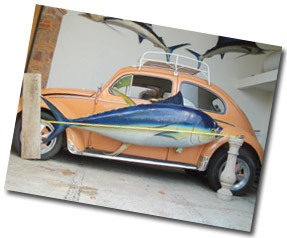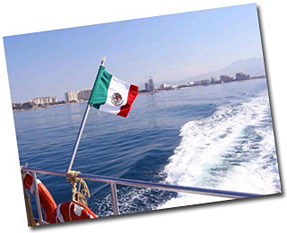
|
 |
 |
 News from Around Banderas Bay | May 2008 News from Around Banderas Bay | May 2008  
Charley Tuna Wished He'd Never Visited Vallarta!
 Jim Scherrer - PVNN Jim Scherrer - PVNN


| | It took almost three hours to land Charley, weighing in at somewhere between 385-390 pounds and 83 inches long. | 
| | Trolling the deep blue Pacific Ocean waters with lures, live, or dead bait will seldom result in a day long boring boat ride. | | |
Nestled in the Sierra Madre foothills along the shore of the 25 mile diameter Banderas Bay on the Pacific Ocean, Puerto Vallarta, Mexico, the beautiful vacation resort destination and retirement haven in the center of the Mexican Riviera boasts of having some of the finest deep sea fishing waters in the world; those found in the deep bay, an extension of a large canyon running from the Sierra Madre Occidentals, and in the ocean just outside of the bay.

Not only are they very deep in certain areas, but the undulating underwater terrain provides safe haven to the deep water game fish. Combined with the varying depths, year-round warm water temperatures, and Pacific currents make conditions ideal for many popular varieties of salt water game fish.

Marlin, Sail Fish, Tuna, and Dorado are those most often pursued by sport fishermen in the Vallarta area. Trolling the deep blue Pacific Ocean waters with lures, live, or dead bait will seldom result in a day long boring boat ride. Instead, you can just about bank on having a number of exhilarating moments when the reels suddenly start screaming and the rods appear to be breaking in half!

The big blue or black Marlin are considered the rarest to find and generally the odds of catching one of these enormous fish are best during the summer months; whereas the sails, tuna, and dorado are found year round with the best time usually during the months of November through January with Vallarta's annual Sailfish Tournament being held in November.

As with fishing in all regions of the world, some years are better than others. For example, during one tournament a few years ago, each boat with two anglers landed an average of five sailfish per day. Some of us caught as many as 15 sails in a single day, with up to three fish hooked simultaneously; all jumping, twisting, and flipping wildly across the horizon. What an exciting moment and what a mess with lines going out and crossing in every direction!

Dorado are probably considered the most beautiful of all the game fish and they are also considered by many to be one of the finest eating fish. They can be caught in the Vallarta area year round, feeding in the bay waters within a few hundred yards of the shore as well as far out at sea. They are often in the 30-50 pound range but the big old bulls can reach 100 pounds or more.

Now, for the toughest fish of them all; the Yellow Fin Tuna. When they come to town, they often arrive in schools; playing and feeding among the dolphins. The yellow fins are commonly in the 50-100 pound range and considered by many to be the best eating fish in the sea, especially in the Orient where they command premium prices.

When the large schools of tuna arrive in PV, so do the huge floating fish factories from the Far East. They are often outfitted with helicopters, speed boats, and large encircling nets or purse seines. The helicopters will hover over the Pacific waters just outside of Banderas Bay in search for the tuna schools.

Once spotted, the speed boats are launched; at which time they proceed to scare and chase the tuna in ever reducing circles, virtually herding them into a small area over the pre-positioned net. On occasion, we have witnessed the illegal use of dynamite; where explosive charges are detonated underwater, thereby killing or stunning every fish or dolphin in the area.

Finally, the nets are drawn up and into the boat, often yielding tons of fish. Aboard these large commercial fishing boats, the fish are often processed and either canned or frozen shortly thereafter.

Aside from being illegal, this type of fishing is terribly detrimental to sport fishing. More importantly, it also destroys every other living creature in the area which often includes the dolphins. This method of fishing is so efficient and effective that if allowed to continue uncontrolled, it would not take many years before the entire tuna species would be eradicated.

Some of us have been fortunate enough to locate the schools before the large commercial fleets arrive and what a thrill it is to see them among the dolphins and birds overhead, all feeding on the small surface water fish. These tuna are typically in the 30-100 pound range and put up a real fight; first heading down and then out. Their bodies are built for strength and speed, thus providing a great deal of excitement and challenge bringing them aboard.

The larger tuna seem to be few and far between and generally not among the schools. On some occasions, we'll find areas just outside Banderas Bay where we might catch five to ten yellow fins in a day, each in the 100-200 pound range. Now, we're starting to get serious; these creatures will really get your attention as you huff and puff for a half hour to an hour bringing them in!

It seems like once or twice a year, usually between December and February, we'll find a couple random monsters ranging anywhere from 200-400 pounds. On one occasion three years ago, we landed a pair of world record sized yellow finned tunas, each in the 380-400 pound category and measuring very close to seven feet in length. The world record is 388 pounds and 83 inches long and many of the tuna of this size are caught in the Vallarta area.

The day we caught these behemoths, it took almost three hours to land Charley, weighing in at somewhere between 385-390 pounds and 83 inches long, and another three hours to land his twin brother Bubba, at an estimated 390-400 pounds and 84 inches long. We had no scales capable of weighing the twins although 20 year veteran fishermen in the area indicated they were the biggest they'd ever seen; probably meeting or exceeding the world record.

Once hooked, these monsters headed straight to the bottom before racing a quarter mile further out from the boat. It was instantly obvious that these were huge tunas because the only other fish of this size and strength in the area are marlin and they tend to swim to the surface and jump into the air.

It required tremendous strength and endurance to land these creatures; more than we individually had to offer. Therefore, we had to alternate being harnessed into the fighting chair every half hour or so and after three hours and two against one, man prevailed over creature.

Talk about an exhausting way to get your exercise for the day; hooking one of these monsters is almost life threatening! Landing one of these 10 year old grand daddies is no longer classified as having fun while fishing; this is very strenuous work for anyone, let alone a couple of geezers that were almost sent into a state of cardiac arrest! One thing was for certain; after landing these giants, we'd had enough fishing for the day!

Charley and Bubba must have provided close to 400 pounds of delicious fresh tuna meat which eventually fed perhaps 100 people in the Vallarta community. Not only did Charley and Bubba have good taste in selecting our boat after living at sea for ten years, but as Star Kist would say, "they tasted good." However, you can rest assured; Charley the Tuna wished he'd never visited Puerto Vallarta!
 The founder of Puerto Vallarta Real Estate Buyers' Agents (PVREBA), Jim Scherrer is a retired entrepreneur who has owned property in Puerto Vallarta for 24 years. Utilizing his experience and extensive knowledge of the area, Jim has written a series of informative articles about travel to and retirement in Puerto Vallarta, which you can read on his website at PVREBA.com. The founder of Puerto Vallarta Real Estate Buyers' Agents (PVREBA), Jim Scherrer is a retired entrepreneur who has owned property in Puerto Vallarta for 24 years. Utilizing his experience and extensive knowledge of the area, Jim has written a series of informative articles about travel to and retirement in Puerto Vallarta, which you can read on his website at PVREBA.com.

Click HERE for more articles by Jim Scherrer | 
 | |
 |



